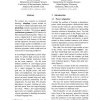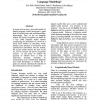175 search results - page 15 / 35 » A Probability Model to Improve Word Alignment |
ACL
2012
11 years 10 months ago
2012
We propose the first joint model for word segmentation, POS tagging, and dependency parsing for Chinese. Based on an extension of the incremental joint model for POS tagging and ...
EMNLP
2009
13 years 5 months ago
2009
We connect two scenarios in structured learning: adapting a parser trained on one corpus to another annotation style, and projecting syntactic annotations from one language to ano...
ACL
1998
13 years 9 months ago
1998
It seems obvious that a successful model of natural language would incorporate a great deal of both linguistic and world knowledge. Interestingly, state of the art language models...
COLING
2000
13 years 9 months ago
2000
Automatic transliteration problem is to transcribe foreign words in one's own alphabet. Machine generated transliteration can be useful in various applications such as indexi...
MT
1998
13 years 7 months ago
1998
We present a quantitative evaluation of one well-known word alignment algorithm, as well as an analysis of frequent errors in terms of this model's underlying assumptions. De...


